The AMD Trinity Review (A10-4600M): A New Hope
by Jarred Walton on May 15, 2012 12:00 AM ESTAMD Trinity Gaming Performance
After the 3DMark results, you might be wondering if Intel has finally caught up to AMD in terms of integrated graphics performance. The answer is…yes and no. Depending on the game, there are times where a fast Ivy Bridge CPU with HD 4000 will actually beat out Trinity; there are also times where Intel’s IGP really struggles to keep pace. The good news is that at least everyone is now onboard the DX11 bandwagon, and compatibility with games has improved yet again for Intel. Here are our “Value” benchmark results for seven recent games; we’ll have more information in a moment.

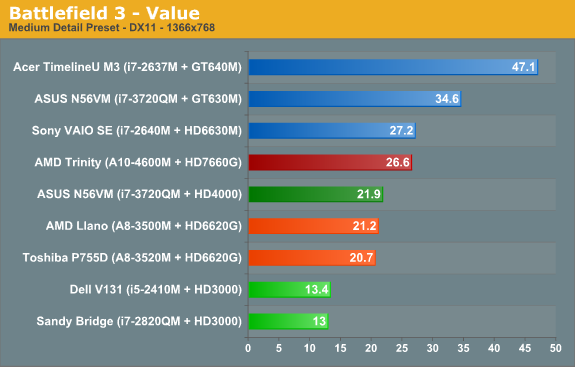
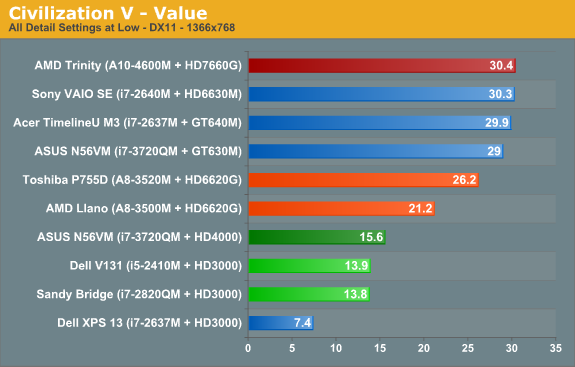

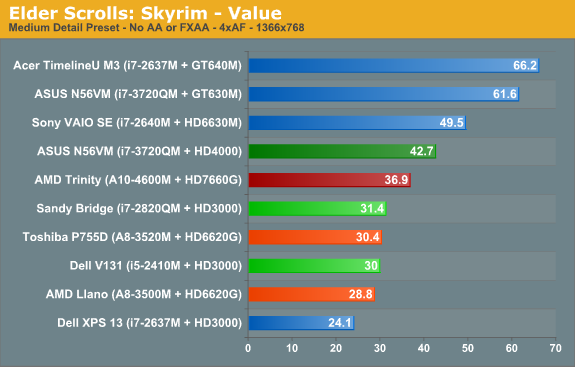
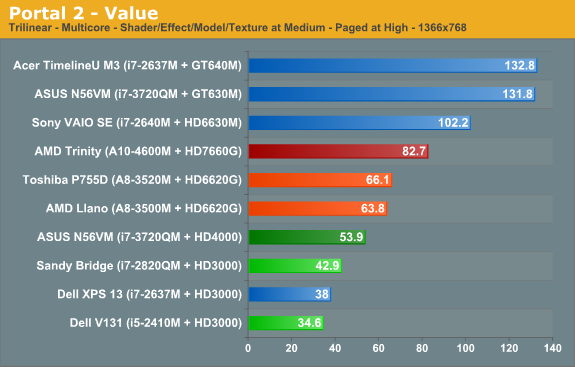
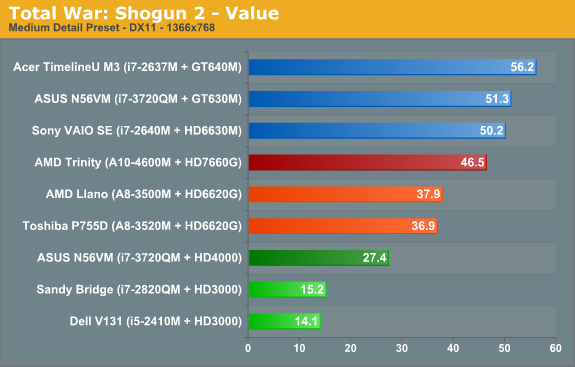
Out of our seven test titles, AMD’s Trinity leads any other IGP in four titles by a large margin. The other three titles actually have Ivy Bridge slightly ahead of Trinity, but the gaps aren’t nearly as big. Overall, the average performance across the seven games at our Value (medium) settings has AMD’s Trinity A10-4600M leading Intel’s i7-3720QM by 21%, and if we look at quad-core Sandy Bridge with HD 3000 (i7-2820QM) Trinity is 72% faster. Trinity is also around 20% faster than 35W Llano on average.
Let’s expand our gaming suite just a bit to see if things change, though. Just like we did with Ivy Bridge, we ran the eight games in our previous benchmark suite at medium detail settings. We can then compare performance across a wider 15 title selection to see how Trinity matches up against HD 4000, HD 3000, and HD 6620G (Llano). We’ll start with the bottom (HD 3000/Sandy Bridge) and move up.
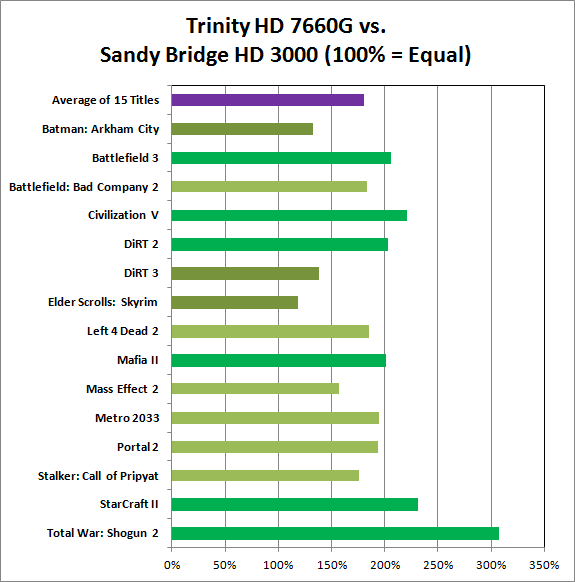
Llano’s HD 6620G was already faster than HD 3000, and Trinity’s HD 7660G is faster than Llano, so the Sandy Bridge gaming matchup is a landslide victory in AMD’s favor. The closest Intel can get is in the same three titles where Ivy Bridge leads Trinity: Batman: Arkham City, DiRT 3, and Skyrim. Here, however, HD 3000 can’t actually close the gap and HD 6620G is at least 20% faster than HD 3000, with an average performance improvement of nearly 80%.
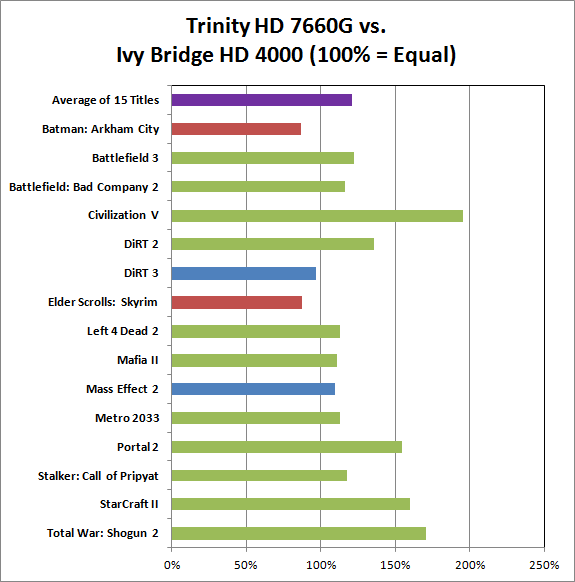
We found that across the same selection of 15 titles, Ivy Bridge and Llano actually ended up “tied”—Intel led in some games, AMD in others, but on average the two IGPs offered similar performance. This chart and the next chart will thus show a similar average increase in performance for Trinity, but the details in specific games are going to be different. Starting with Ivy Bridge and HD 4000, as with our earlier game charts we see there are some titles where Intel leads (Batman and Skyrim), a couple ties (DiRT 3 and Mass Effect 2), and the remainder of the games are faster on Trinity. Mafia II is close to our <10% “tie” range but comes in just above that mark, as do Left 4 Dead 2 and Metro 2033. The biggest gap is Civilization V, where Intel’s various IGPs have never managed good performance; Trinity is nearly twice as fast as Ivy Bridge in that title. Overall, it's a 20% lead for Trinity vs. quad-core Ivy Bridge.
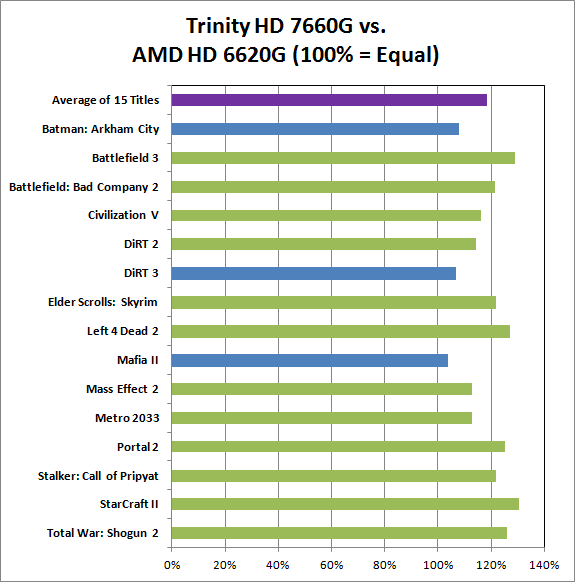
Against Llano, Trinity is universally faster, but the smallest gap is in Mafia II (3%) while the largest gap is in StarCraft II (30%). On average, looking at these games Trinity is only 18% faster than Llano. What’s not entirely clear from the above chart is whether we’re hitting CPU limitations, memory bandwidth limitations (remember that Llano and Trinity share bandwidth with the rest of the system), or perhaps both. At our chosen settings, what is clear is that Trinity’s “up to 56% faster” graphics never make it that high.
We saw 35-45% higher scores in 3DMark 11 and Vantage, which tend to remove the CPU from the equation more than actual games, so our guess would be that if AMD continues with their APU plan they’re going to need to work more on the CPU side of the equation. We also see the same thing looking at the VAIO SE scores in the earlier gaming charts: the HD 6630M scores are 20% faster on average, but much of that appears to come from the faster CPU rather than the GPU.










271 Comments
View All Comments
Burticus - Tuesday, May 15, 2012 - link
I wonder if they will release standalone mobile chips and if they are the same socket as the current Llano? Currently my laptop has an A8-3500 and I wouldn't mind upping to an A10.They did this in the past with the S1 socket, I wonder if it will be an option nowadays...
For the most part I've been pretty impressed with the A8 for a $500 laptop (especially with some overclocking). Games are playable at moderate settings. Civ 5 still kicks it in the teeth though, and I see that the A10 got a 10fps jump which would be nice.
JarredWalton - Tuesday, May 15, 2012 - link
The sockets are different: FS1r2 this time. I don't know precisely what changed, but apparently it's enough that AMD isn't making them backwards compatible.Fallen Kell - Tuesday, May 15, 2012 - link
The biggest problem with the design is that the OS doesn't know how to work with the CPU. Take the case where you have 2 of these piledrivers, with 1 floating point intensive job and 1 non-floating point intensive job already running, in which case the OS will place the first job, on one piledriver, and the next on the other piledriver. Then a user starts a new floating point intensive job, and the OS simply puts it on the next free core, which happens to be the one already running a floating point intensive application, and thus, you just bottlenecked both of those processes. The OS doesn't know if a process is floating-point heavy or not, and thus, can not properly schedule it to a core which has a floating point unit not in heavy use. That is why bulldozer failed. It is also why my work will never purchase it, as they do floating point intensive applications.Beenthere - Tuesday, May 15, 2012 - link
Most every reviewer has indicated that Trinity is a significant jump in performance in both CPU and GPU with extended battery performance yet some reviewers seem hard pressed to admit that for 90% of the laptop market Trinity is superior to Intel's best offerings.Some reviewers are trying to pretend that Intel's faster CPU performance some how is of importance to the majority of the laptop market when in fact it is not unless all you do is crunch numbers. I think Trinity sales just like llano and brazos will drive the point home who is leading the laptop market segment with what consumers actually desire.
JarredWalton - Tuesday, May 15, 2012 - link
Beenthere, you have to be the biggest AMD fanatic I've seen around here. EVERY article where AMD comes up, you're there making things up to justify your worldview. As I indicate in the article, Trinity is 10-20% faster than Llano on CPU and 20% faster on GPU, which is a decent improvement. Unfortunately, a lot of places are quoting AMD's "up to 29% faster CPU and 56% faster GPU" and calling it a day. Those are results that just didn't show up in any testing that I conducted.Oh, wait, I've got one: using OpenCL in GIMP, Trinity is 72% faster than Llano! There, we now have one statistic you can point to where Trinity is better. For the 0.1% of the population that uses GIMP, and not even them really -- it's the 0.1% of people that use GIMP and will some day benefit when the next major release comes out and incorporates OpenCL. If you can't see the problem with that statement, I can't help you.
For 90% of the market, Trinity might be enough, but to say it's "better than Intel's best" is pure fanaticism and nothing more. You are more biased than AMD's own marketing department. To pretend that moderately faster graphics with substantially less CPU performance is somehow more important than any other metric is insane. Sandy Bridge with GT 540M can be had for $600 right now, and it will beat Trinity in pretty much every single metric. Lucky for AMD, a lot of people like you will blindly purchase anything with AMD on it without regard for reality.
bji - Tuesday, May 15, 2012 - link
While I agree with your points overall, I think there is a fine detail you need to consider:Benchmarks are only an approximation of the performance results that would be achieved on a whole variety of processor tasks. You can rightly point out that only a small fraction of tested programs benefitted greatly from improved OpenCL performance, but you can't claim that this only benefits the 0.1% of people that use GIMP and care about OpenCL, because there may be other programs available now, or in the future, that would see similar performance increases. What your benchmarking shows is that *most* programs don't see a huge OpenCL performance benefit, but that *some* do. This is likely to lead to a more significant performance benefit than would be enjoyed by 0.1% of the users of a particular application.
However, I think that CPU reviewers are kind of in a hard place these days, since we're arguing over how big of an overkill one given processor is than another when considered for a wide variety of tasks, which starts to make any benchmarking about trying to find benchmarks where the performance difference would really matter. And that invites all kinds of debate about which kinds of performance actually matter to the average user, which is not a very fun or interesting argument.
CPU performance can still matter for targeted tasks, but that kind of analysis requires a very different approach and is very user-specific, when compared to standard benchmarking.
JarredWalton - Tuesday, May 15, 2012 - link
You're correct, and the real difficulty is first in finding anything where OpenCL is clearly faster, and then seeing similar techniques used in other software. Office for example isn't going to really get any faster because of you GPU or OpenCL -- and it doesn't need to be. Office spends its time waiting for user input. So what we really need are technologies that make the slow parts of using a computer faster. SSDs are a perfect example, because they make the initial boot and application load times all faster. OpenCL isn't doing that for the vast majority of applications, and neither is Quick Sync or DirectX or whatever other GPU related task you want to throw out there. They make graphics faster, but in my experience that's mostly important to gamers, or for high-end workstation stuff where you want OpenGL support.For many people, Core 2 Duo is fast enough, and Llano is fast enough, and Trinity is fast enough, etc. So for those users, it's about delivering the lowest cost. Trinity is twice the size of quad-core Ivy Bridge, so Intel could easily start a price war if they wanted, but they'd rather keep higher margins. Sandy Bridge laptops at $600 are still faster for general use than Llano and Trinity, particularly if they have an Optimus GPU around. Unless something is significantly faster in some important metric -- and I really don't see any single area where that's the case for Trinity -- then you just get whichever is the best price.
Beenthere - Tuesday, May 15, 2012 - link
Wow, Jarred is having an unhappy day! :(Obviously AMD's testing is different than your's as is other websites. My comments were NOT in regards to your article, which I though was pretty balanced. The website I was referring to is listed below.
Your knee-jerk reaction to my comment however shows you're loosing it. If you really believe that Intel's platform provides as good a result for mainstream consumers, you'd be in error especially when Trinty Ultrathins will be hundreds cheaper.
It's pretty obvious you can't deal with differing POVs and you get upset when you're opinion is not shared by others. Losing your objectivety makes it difficult for anyone to take your articles seriously - even though this one was pretty balanced. You should consider a CHILL PILL before over-reacting.
You really should THINK before you react. In this case my comment had NOTHING to do with your story. If your article has merit then you should not need to go POSTAL even if my comment was about your story. Being a reactionary and calling people names for having a different POV than you shows immaturity. The really funny part about your knee-jerk reaction was my comment was in regard to another story on Trinity on a different website. (see below).
You must have a guilty conscience? Below is the story I commented on. Oops, I'm sure you are embarrassed now, but it's OK? I don't hold grudges. <LOL>
Maybe the Intel fanbois are just beating you up too much because Trinity is a far better choice for laptops than anything Intel has at the moment? they'll get over it.
http://www.pcper.com/reviews/Mobile/AMD-A10-4600M-...
Cheer up Jarred. You can look forward to Piledriver/Vishera in a few months and more hate from the Intel fanbois.
bji - Tuesday, May 15, 2012 - link
Sorry, but when you start a paragraph with "Some reviewers are trying to pretend" you are VERY CLEARLY implicating that the reviewer is being dishonest by trying to mislead people reading the review by stating intentionally false commentary.If you start with that kind of premise, then you deserve a response that, in kind, accuses you of doing the same, which is exactly what you got.
Trying to then pretend that you're innocent and didn't deserve that response is just more lameness.
JarredWalton - Tuesday, May 15, 2012 - link
Beenthere is your typical passive aggressive anonymous Internet poster. I called him on his post, and now he backpedals. You know what's hilarious, Beenthere? That article you link. Let me give you a quote from the conclusion to show what I'm talking about:"I can’t find a way to look at Trinity that paints a favorable picture. Though certainly an improvement over Llano, it’s not enough. AMD is way behind Intel in processor performance, and the graphics performance does not offer redemption. The only way systems based off Trinity will be made competitive is by slashing and burning the prices."
Okay, that's pretty much what I said as well. Perhaps they're even more negative than I am. And yet... that paragraph is followed by a Silver Award? WTF is up with that? They're awarding something that they can't find a way to describe in a positive fashion? And then you suggest that "Some reviewers are trying to pretend that Intel's faster CPU performance some how is of importance to the majority of the laptop market when in fact it is not unless all you do is crunch numbers." I'd say the opposite: some reviewers are trying to kiss up to AMD with an award or backhanded praise when everything else they say is negative at best.
But hey, let's not forget how open and unbiased Beenthere is. Here's a quote from page three of the comments that shows his amazing analytical skills and not-at-all-anti-Intel mindset:
Subject: Excellent by Beenthere on Tuesday, May 15, 2012
As expected Trinity delivers in all areas and should meet most people's needs quite well. Good job AMD. You get my money!
Wow. Yup, Trinity is a far better choice for laptop than anything Intel has at the moment. Because Acer's AS4830TG with GT 540M and i5-2410M at $600 offers better CPU performance and better GPU performance. Yup. Far better. I like to pay more for less!